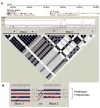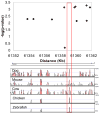Insertion-deletions in a FADS2 intron 1 conserved regulatory locus control expression of fatty acid desaturases 1 and 2 and modulate response to simvastatin
- PMID: 22748975
- PMCID: PMC3404253
- DOI: 10.1016/j.plefa.2012.04.011
Insertion-deletions in a FADS2 intron 1 conserved regulatory locus control expression of fatty acid desaturases 1 and 2 and modulate response to simvastatin
Abstract
The fatty acid desaturase genes (FADS1 and FADS2) code for enzymes required for synthesis of omega-3 and omega-6 long-chain polyunsaturated fatty acids (LCPUFA) important in the central nervous system, inflammatory response, and cardiovascular health. SNPs in these genes are associated with numerous health outcomes, but it is unclear how genetic variation affects enzyme function. Here, lymphoblasts obtained from Japanese participants in the International HapMap Project were evaluated for association of expression microarray results with SNPs in the FADS gene cluster. Six SNPs in the first intron of the FADS2 gene were associated with FADS1 expression. A 10-SNP haplotype in FADS2 (rs2727270 to rs2851682) present in 24% of the population was associated with lower expression of FADS1. A highly conserved region coinciding with the most significant SNPs contained predicted binding sites for SREBP and PPARγ. Lymphoblasts homozygous for either the major or minor haplotype were treated with agonists for these transcription factors and expression of FADS1 and FADS2 determined. Simvastatin and the LXR agonist GW3965 both upregulated expression of FADS1 and FADS2; no response was found for PPARγ agonist rosiglitazone. The minor haplotype homozygotes had 20-40% higher induction of FADS1 and FADS2 after simvastatin or GW3965 treatment. A 22 bp polymorphic insertion-deletion (INDEL) was found 137 bp downstream from the putative sterol response element, as well as a 3 or 1 bp INDEL 81-83 bp downstream. All carriers of the minor haplotype had deletions while all carriers of the major haplotype had insertions. Individuals carrying the minor haplotype may be vulnerable to alterations in diet that reduce LCPUFA intake, and especially responsive to statin or marine oil therapy.
Copyright © 2012 Elsevier Ltd. All rights reserved.
Figures





Similar articles
-
Desaturase and elongase-limiting endogenous long-chain polyunsaturated fatty acid biosynthesis.Curr Opin Clin Nutr Metab Care. 2016 Mar;19(2):103-10. doi: 10.1097/MCO.0000000000000254. Curr Opin Clin Nutr Metab Care. 2016. PMID: 26828581 Free PMC article. Review.
-
Tissue-specific impact of FADS cluster variants on FADS1 and FADS2 gene expression.PLoS One. 2018 Mar 28;13(3):e0194610. doi: 10.1371/journal.pone.0194610. eCollection 2018. PLoS One. 2018. PMID: 29590160 Free PMC article.
-
FADS1-FADS2 genetic polymorphisms are associated with fatty acid metabolism through changes in DNA methylation and gene expression.Clin Epigenetics. 2018 Aug 29;10(1):113. doi: 10.1186/s13148-018-0545-5. Clin Epigenetics. 2018. PMID: 30157936 Free PMC article.
-
Associations between variants of FADS genes and omega-3 and omega-6 milk fatty acids of Canadian Holstein cows.BMC Genet. 2014 Feb 17;15:25. doi: 10.1186/1471-2156-15-25. BMC Genet. 2014. PMID: 24533445 Free PMC article.
-
Genetic variants of the FADS1 FADS2 gene cluster as related to essential fatty acid metabolism.Curr Opin Lipidol. 2010 Feb;21(1):64-9. doi: 10.1097/MOL.0b013e3283327ca8. Curr Opin Lipidol. 2010. PMID: 19809313 Review.
Cited by
-
Dietary adaptation of FADS genes in Europe varied across time and geography.Nat Ecol Evol. 2017 May 26;1:167. doi: 10.1038/s41559-017-0167. Nat Ecol Evol. 2017. PMID: 29094686 Free PMC article.
-
Atorvastatin increases Fads1, Fads2 and Elovl5 gene expression via the geranylgeranyl pyrophosphate-dependent Rho kinase pathway in 3T3-L1 cells.Mol Med Rep. 2017 Oct;16(4):4756-4762. doi: 10.3892/mmr.2017.7141. Epub 2017 Aug 2. Mol Med Rep. 2017. PMID: 28765914 Free PMC article.
-
Fatty acid desaturase insertion-deletion polymorphism rs66698963 predicts colorectal polyp prevention by the n-3 fatty acid eicosapentaenoic acid: a secondary analysis of the seAFOod polyp prevention trial.Am J Clin Nutr. 2024 Aug;120(2):360-368. doi: 10.1016/j.ajcnut.2024.06.004. Epub 2024 Jun 13. Am J Clin Nutr. 2024. PMID: 38879016 Free PMC article. Clinical Trial.
-
Desaturase and elongase-limiting endogenous long-chain polyunsaturated fatty acid biosynthesis.Curr Opin Clin Nutr Metab Care. 2016 Mar;19(2):103-10. doi: 10.1097/MCO.0000000000000254. Curr Opin Clin Nutr Metab Care. 2016. PMID: 26828581 Free PMC article. Review.
-
Selection in Europeans on Fatty Acid Desaturases Associated with Dietary Changes.Mol Biol Evol. 2017 Jun 1;34(6):1307-1318. doi: 10.1093/molbev/msx103. Mol Biol Evol. 2017. PMID: 28333262 Free PMC article.
References
-
- Schmitz G, Ecker J. The opposing effects of n-3 and n-6 fatty acids. Prog Lipid Res. 2008;47(2):147–55. - PubMed
-
- Calder PC. Polyunsaturated fatty acids and inflammatory processes: New twists in an old tale. Biochimie. 2009;91(6):791–5. - PubMed
-
- Brookes KJ, et al. Association of fatty acid desaturase genes with attention-deficit/hyperactivity disorder. Biol Psychiatry. 2006;60(10):1053–61. - PubMed
-
- Schaeffer L, et al. Common genetic variants of the FADS1 FADS2 gene cluster and their reconstructed haplotypes are associated with the fatty acid composition in phospholipids. Hum Mol Genet. 2006;15(11):1745–56. - PubMed
Publication types
MeSH terms
Substances
Grants and funding
LinkOut - more resources
Full Text Sources
Other Literature Sources
Medical

